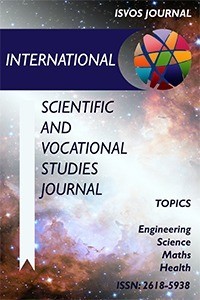Investigation of Buckling Behavior of Beams with Artificial Neural Network
Neural Network Algorithm, Buckling, Beam, Critical Buckling Load, Neural Network Algorithm, Buckling, Beam, Critical Buckling Load
Investigation of Buckling Behavior of Beams with Artificial Neural Network
Neural Network Algorithm, buckling, beam, critical buckling load”,
___
- Referans 1 S. Timoshenko and M.G. James, Theory of Elastic Stability, New York: McGraw-Hill, 1961.
- Referans2. Z.P. Bazant and L. Cedolin, Stability of Structures: Elastic, Inelastic, Fracture and Damage Theories. New York: Oxford University Press. 1991.
- Referans3 S. Albayrak, Yanal burkulma etkisindeki I kesitli kirişlerde ideal desteklerin belirlenmesi ve yapay sinir ağları yaklaşımı, doktora tezi, Karadeniz Teknik Üniversitesi, Fen bilimleri Enstitüsü, 2011.
- Referans 4 M.R. Sheidaii, R. Bahraminejad, “Evaluation of compression member buckling and post-buckling behavior using artificial neural network”, Journal of Constructional Steel Research, vol. 70, p. 71-77, 2012.
- Referans 5 M. Hosseinpour, Y.Sharifi, H. Sharifi, “Neural network application for distortional buckling capacity assessment of castellated steel beams”, Structures, vol. 27, p. 1174-1183, 2020.
- Referans 6 R.R. Kumar, T. Mukhopadhya, K.M. Pandey, S. Dey, “Chapter 5 - Prediction capability of polynomial neural network for uncertain buckling behavior of sandwich plates”, Handbook of Probabilistic Models, p. 131-140, 2020.
- Referans7 Z. Sun, Z. Lei, R. Bai, H. Jiang, J. Zou, Y. Ma, C.Yan, “Prediction of compression buckling load and buckling mode of hat-stiffened panels using artificial neural network”,Engineering Structures, vol. 242, p. 112275, 2021.
- Referans8 F. Susac, E.F. Beznea and N. Baroiu , “Artificial neural network applied to prediction of buckling behavior of the thin-walled box” Advanced Engineering Forum 21, p.141-150, 2016.
- Referans9 Z. Chi, Z. Jiang, M.M. Kamruzzaman, B.A. Hafshejaniü M. Safarpour, “Adaptive momentum-based optimization to train deep neural network for simulating the static stability of the composite structure”. Engineering with Computers, online,1 mart 2021.
- Referans10 S Guzel and E Gurses, “Determination of the 1st Buckling and Collapse Loads for Integrally Stiffened Panels by Artificial Neural Network and Design of Experiment Methodology”, IOP Conf. Ser.: Mater. Sci. Eng. 1024, 012080,2021.
- ISSN: 2618-5938
- Yayın Aralığı: Yılda 2 Sayı
- Başlangıç: 2017
- Yayıncı: Umut SARAY
Investigation of Buckling Behavior of Beams with Artificial Neural Network
Munise Didem DEMİRBAŞ, Murat OĞUZ, İbrahim ERİŞEN
Comparison of Selling Prices of Raw Wood Materials in Terms of Sale Times in Turkey
Emrah KABASAKAL, Ahmet TOLUNAY
A Suggestion To Ensure Speech Privacy In Multi-Bed Treatment Units During Covid-19 Pandemia
The Role of Feature Selection in Significant Information Extraction from EEG Signals
Being an Mechanical Engineering Student During the Pandemic Process
Uğur ÇAVDAR, Pınar ÇAVDAR, Mustafa Murat YAVUZ
Interactive Use of Graphic Tools as a Design Process from Image to Reality: Project Example
Özgür ALPARSLAN, Öznur ÇETİN, Ayşe ÇATALOLUK, Ayşenur KAHRAMAN
